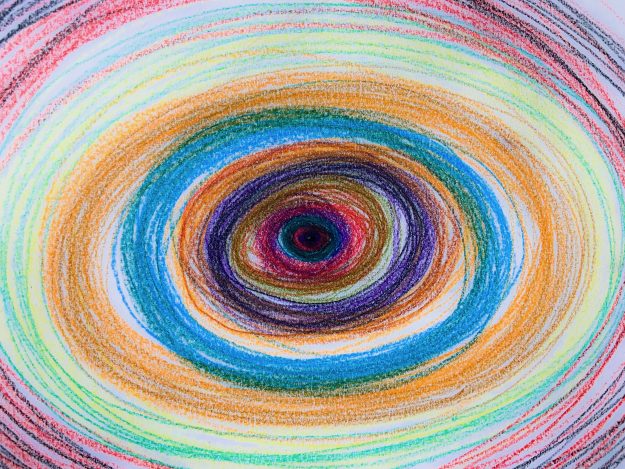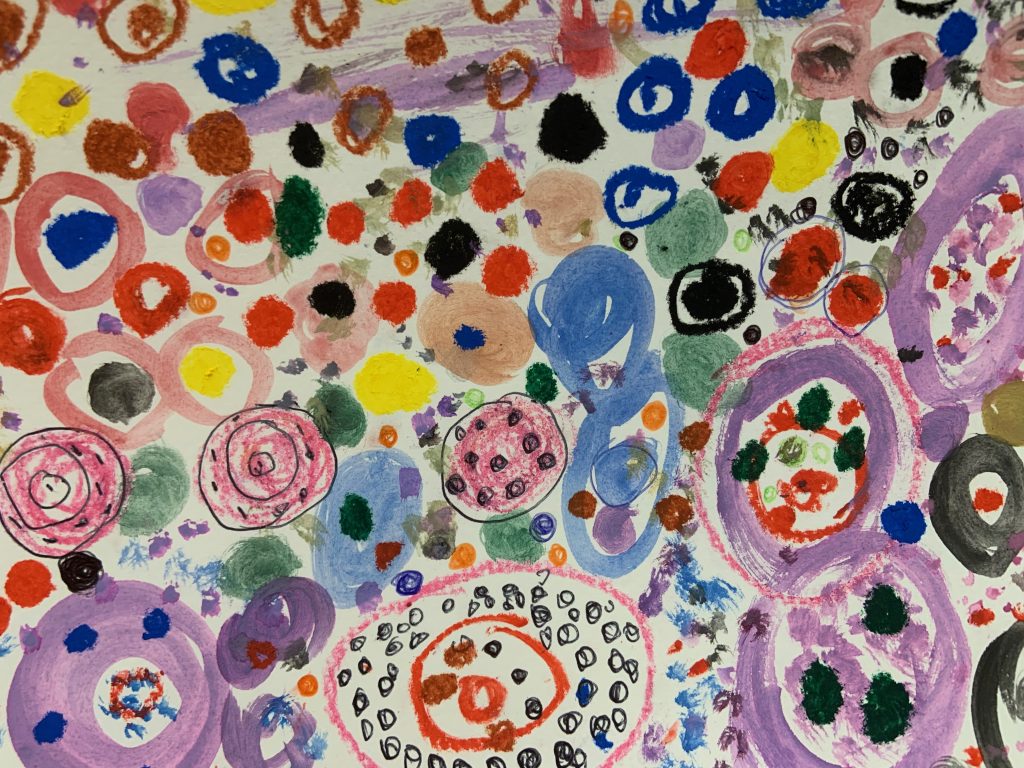A mournful violin echoes hauntingly as “Anna” stills her wrinkled hands to draw. The 70-something concentrates on the task at hand with her eyes closed. After initially resisting instruction, her defiance softens as she learns to trust her instincts; a smile of surprise spreads across her lips as she allows her creativity to express itself. Despite her advanced years, she exhibits a youthful verve while arriving for our weekly workshops, even as she works in silence.
As a widow who spends most of her time alone, Anna initially doubted meditation’s ability to reduce anxiety, sharpen her focus, settle her nervous system, and contribute to her well-being. Yet, as the weeks pass, it’s impossible not to notice a change in her as she taps into her creativity at this stage in life. I marvel as she relaxes into the spaciousness of mind that connects her to something greater, as she settles into the flow state, which feels like a little miracle unraveling. As a professed Roman Catholic who attends weekly Mass, she associates these experiences as akin to connecting with God, a confession she shares with me months later.
Close by, seven other women perform the same art-making prompt with their own individual flair. Their hands and faces are worn with the hard lines of time and experience, with the setbacks and breakthroughs that have brought each of them to the Lehman Village Senior Center in East Harlem. The facility is operated by the Carter Burden Network, a nonprofit offering programs that alleviate social isolation and food insecurity, and address health and wellness needs to improve the quality of life for older adults.
Each participant marks her canvas with dots representing single moments in time, a mindfulness exercise I assign for reflecting on the fleetingness of life in the abstract. Their faces mirror the moods each memory unleashes as they draw and paint—the heartache of losing husbands, the innocent joy exhibited in their grandchildren, the trials of childhoods spent in rural communities in Puerto Rico and the Dominican Republic, the illnesses that robbed them of friends and family. They reveal these snapshots while presenting their pieces during the storytelling exchanges that close each session.
I came to this work with the Carter Burden Network seemingly by chance. After completing Tibet House’s 100-Hour Mindfulness Meditation Teacher Training with David Nichtern in 2020, I began to meet with undocumented students, queer youth of color, recovery groups, frontline residents, and the chronically ill after the pandemic devastated the immigrant, working-class communities where they (and I) lived in the Bronx, Queens, and elsewhere.
Sheltering in place had ravaged my former sense of self, as I lost so much that I’d become familiar with, including the Buddhist mentor who became like a father to me, my consulting contracts, and, even, my apartment. But rather than shielding myself from this suffering, I met it with generosity, compassion, and creativity—the tools of my teaching craft and, simultaneously, the dharma. While I, too, despaired in the wave of upheaval that swept over us during the early days of COVID, I also embraced it as an opportunity to transform the suffering into something greater: a purpose to serve others.
In 2021, The Clemente, a Puerto Rican/Latinx arts institution, proposed a partnership to serve elderly residents on the Lower East Side as dementia and mortality rates skyrocketed due to pandemic isolation. We launched CUENTOS in response to this crisis, a meditation and storytelling initiative for Black, Latinx, and Asian seniors. Participants reported reductions in physical pain, anxiety, and insomnia as well as improved mood, focus, and concentration, which they credited to meditation combined with the intercultural exchanges that made them feel seen, heard, and alive. The program exceeded our expectations.
While designing CUENTOS, I learned that mindfulness practice can lead to changes in brain structure and function, which can impact mental and physical well-being by increasing our resilience to stress. I also found that regular mindfulness practice can improve executive control and emotion regulation in older adults, which could support cognitive health as well as coping with the difficulties of aging (in addition to pandemic-related trauma). In a paper by Susan H. McFadden, PhD, the psychologist notes that “positive social interactions can nurture resilience and creative engagement among older persons, including those living with dementia.” The motivational, attentional, and social aspects of arts activities can offer meaningful opportunities for the elderly to express themselves and strengthen this resilience.
By combining meditative and creative exercises—a practice known as “creative mindfulness”—I developed a method that allows my students to lead with their strengths. Some of them benefit most from contemplating their breath or focusing on sound meditations. Others thrive by relaxing into their creativity or engaging in lively storytelling as they present their artworks to the group at the end of each session.
I see this clearly while guiding “Carla,” a 70-something who spends much of her precious time with her children and grandchildren when she isn’t visiting relatives in Puerto Rico. I marvel as she draws ovals to the sound of resonating meditation bowls, whenever she pulls away from the negative daydreaming that causes her suffering, the revisiting of regrets and losses, the worrying over what might happen—most of which is beyond her control. By returning her focus to the present, she’s learned to connect to something greater—to her inner calm, to the silence beneath the noise, to the community of women who have become like a family to her since exhibiting their artworks together in 2023—something, as a church-going Catholic, that she equates to spiritual in nature.

She’s come a long way since the restlessness that prevented her from focusing when she joined the group in 2023, the anxiety gripping her whenever she closed her eyes for a drawing exercise. Things changed once I taught her to follow each breath as it enters the body, to visualize it as it flows out, and to settle into relaxation through mindfulness of breathing: to slow down and witness life as it unravels, one moment at a time.
Each ellipse she draws represents a beginning, a growth, and an end, a cycle of impermanent existence—the birth, life, and death of people she’s known. The overlapping rings create a hypnotic effect as the composition emerges from the depths of consciousness where her wisdom and instincts reside, an artwork that captures the lived and subconscious stories that surface as she meditates on impermanence. She reflects that life comes and goes.
Of the hundreds of students I’ve served, only a few have identified as Buddhist, a testament to the dharma’s transcendent capacity for meeting us wherever we are at. I witness this timeless wisdom whenever my students immerse themselves in the art-making prompts that double as mindfulness exercises, when teachings such as the Buddha’s Satipatthana Sutta, or “The Discourse on the Establishing of Mindfulness,” come to mind, as included in the Majjhima Nikaya (or the Middle-Length Discourses) of the Pali canon.
In his introduction to the sutta, Theravada teacher Thanissaro Bhikkhu explains that: “the role of mindfulness is to keep the mind properly focused in frames of reference that will give it guidance in what present events to develop, and which ones to abandon, so as to keep it on the path.”
While not Buddhist or seeking liberation or enlightenment, nearly all my students have recognized impermanence—the inevitability of sickness, old age, and death—as they focus on the movements of the breath. This intimacy with self and spirit seems to ground them, so much so that, after a recent breathing exercise, Laura, a wheelchaired elder of Jamaican heritage, proclaimed, “Meditation makes me feel closer to God.”
Expressing our kindness and selflessness is the wisest investment we can make in a world gripped by so much anguish
Laura now awaits me in the classroom as I arrive each week. This comes after refusing to participate due to her poor eyesight. Intent on transforming this obstacle into an opportunity, I handed her a paintbrush and placed a tray of watercolors before her. “Paint with your mind,” I told her. Dabbing color onto my brush, I danced it around a sheet of paper with my eyes closed. “Let your hands serve your imagination,” I added. Awakened by this new possibility at nearly 80 years old, each session she brings her colorful inner world to life for others to glimpse.
Working with the elderly has taught me to present mindfulness exercises as forms of prayer, as rituals for connecting them to the mysteries of God, to the benevolent Christ they turn to for hope. It is something that I can identify with as well, as it was the same religion I was brought up in before taking refuge in the Buddha, dharma, and sangha. This mindfulness, this prayer, has awakened in me the wisdom of finding happiness in a child’s laughter, in scurrying squirrels—in the spark of kindness in a stranger’s gaze as he passes by and fades away. In simple things—how time rises in value in proportion to its scarcity. How we’re lucky to share this precious human birth despite the anger, attachment, and ignorance that make things difficult at times.
Expressing our kindness and selflessness is the wisest investment we can make in a world gripped by so much anguish but also magic—perhaps, rebirth.
“See you next week,” I say as I leave each week.
“God willing,” Laura says, knowing nothing’s guaranteed.
Thank you for subscribing to Tricycle! As a nonprofit, we depend on readers like you to keep Buddhist teachings and practices widely available.
